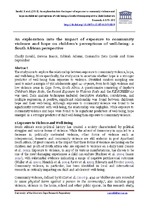An exploration into the impact of exposure to community violence and hope on children's perceptions of well-being: a South African perspective

View/
Date
2013Author
Savahl, Shazly
Isaacs, Serena
Adams, Sabirah
Carels, Cassandra Zeta
September, Rose
Metadata
Show full item recordAbstract
The study aims to explore the relationship between exposure to community
violence, hope, and well-being. More specifically, the study aims to ascertain whether
hope is a stronger predictor of well-being than exposure to violence. Stratified
random sampling was used to select a sample of 566 adolescents aged 14–17 years,
from both high violence and low violence areas in Cape Town, South Africa. A
questionnaire consisting of Snyder’s Children’s Hope Scale, the Recent Exposure to
Violence Scale and the KIDSCREEN-52 was used. Data analysis techniques included
descriptive statistics, correlations, and multiple regression. A positive, significant
relationship was found between children’s hope and their well-being. Although
exposure to community violence was found to be significantly correlated with wellbeing,
the relationship was negligible.While exposure to community violence and hope
were found to be significant predictors of well-being, hope emerged as a stronger
predictor of child well-being than exposure to community violence.
